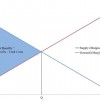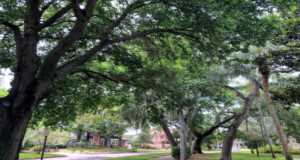This new 13-page article combines canopy coverage data from all of Florida’s metropolitan and micropolitan areas with ecological models developed by the USDA Forest Service to calculate several key benefits of urban trees and an approximation of their monetary value. Benefits of urban trees include carbon sequestration/storage, air pollution filtration, and stormwater mitigation. Written by Drew C. McLean, Andrew K. Koeser, Deborah R. Hilbert, Shawn Landry, Amr Abd-Elrahman, Katie Britt, Mary Lusk, Michael G. Andreu, and Robert J. Northrop, and published by the UF/IFAS Environmental Horticulture Department.
https://edis.ifas.ufl.edu/ep595
Tag: Economic Value of the Environment
Improving, Restoring, and Managing Natural Resources on Rural Properties in Florida: Sources of Financial Assistance
Interested in conserving natural resources, such as wildlife habitat, or protecting the agricultural heritage of your land? Both federal and state governments have technical and financial assistance programs to help rural landowners achieve natural resource goals. These challenges are addressed through land rentals, technical assistance, cost-shares, and incentive payments and include both time-limited and permanent land-use options.
This 8-page fact sheet written by Chris Demers, Martin B. Main and Mark E. Hostetler and published by the UF School of Forest Resources and Conservation informs landowners about government programs available to help conserve natural resources.
http://edis.ifas.ufl.edu/fr156
Valuing the Recreation Uses of Natural Resources: The Travel Cost Method
 Many available statistics provide evidence that outdoor recreation in Florida generates economic value, but these data do not capture the full recreation value of Florida’s natural resources. The Travel Cost Method (TCM) approach may be applied in cost-benefit analysis and in natural resource damage assessments where recreation values are relevant. This 8-page fact sheet summarizes and synthesizes economic texts on TCM and provides an overview of a case study in which the TCM was used to estimate the nature-based recreation use value of the Apalachicola River Region in Florida. Written by Elizabeth F. Pienaar, and published by the UF Department of Wildlife Ecology and Conservation, January 2014.
Many available statistics provide evidence that outdoor recreation in Florida generates economic value, but these data do not capture the full recreation value of Florida’s natural resources. The Travel Cost Method (TCM) approach may be applied in cost-benefit analysis and in natural resource damage assessments where recreation values are relevant. This 8-page fact sheet summarizes and synthesizes economic texts on TCM and provides an overview of a case study in which the TCM was used to estimate the nature-based recreation use value of the Apalachicola River Region in Florida. Written by Elizabeth F. Pienaar, and published by the UF Department of Wildlife Ecology and Conservation, January 2014.
http://edis.ifas.ufl.edu/uw386
Measuring the Economic Value of the Environment and Natural Resources
 Conservation of natural resources requires investments of money, time, and effort by the government, businesses, landowners, conservation organizations, and the general public. Policies to conserve and manage natural resources should be based on a careful accounting of both the benefits and costs of conserving these resources. In a prior EDIS document, cost-benefit analysis and the role it plays in natural resources management and policy was discussed. This document extends that previous discussion by presenting more detailed information about how economists categorize the benefits of natural resources. This 4-page fact sheet was written by Elizabeth Pienaar, and published by the UF Department of Wildlife Ecology and Conservation, December 2014.
Conservation of natural resources requires investments of money, time, and effort by the government, businesses, landowners, conservation organizations, and the general public. Policies to conserve and manage natural resources should be based on a careful accounting of both the benefits and costs of conserving these resources. In a prior EDIS document, cost-benefit analysis and the role it plays in natural resources management and policy was discussed. This document extends that previous discussion by presenting more detailed information about how economists categorize the benefits of natural resources. This 4-page fact sheet was written by Elizabeth Pienaar, and published by the UF Department of Wildlife Ecology and Conservation, December 2014.
http://edis.ifas.ufl.edu/uw385
The Use of Cost-Benefit Analysis in Environmental Policy
 When analyzing environmental problems, economists consider both the benefits and costs of actions. If benefits exceed costs then economic theory supports that action. For example, if the total benefits of conserving land exceed the costs then cost-benefit analysis would support conservation of the land. However, great care must be taken to accurately identify and quantify benefits and costs to determine whether an action is cost-benefit justified. Stakeholders may have an incentive to overstate costs or benefits, in order to influence decision-making. This 5-page fact sheet was written by Elizabeth F. Pienaar, and published by the UF Department of Wildlife Ecology and Conservation, September 2013.
When analyzing environmental problems, economists consider both the benefits and costs of actions. If benefits exceed costs then economic theory supports that action. For example, if the total benefits of conserving land exceed the costs then cost-benefit analysis would support conservation of the land. However, great care must be taken to accurately identify and quantify benefits and costs to determine whether an action is cost-benefit justified. Stakeholders may have an incentive to overstate costs or benefits, in order to influence decision-making. This 5-page fact sheet was written by Elizabeth F. Pienaar, and published by the UF Department of Wildlife Ecology and Conservation, September 2013.
http://edis.ifas.ufl.edu/uw383
The Green Value of Your Woods: A Summary of Ecosystem Services Provided by Forest Stewardship Lands in Florida
 Lands enrolled in voluntary forest management and conservation programs, like the Forest Stewardship Program, promote good land management practices. In addition to benefiting the landowners enrolled in these programs, good land management provides ecosystem services to society. The Stewardship Ecosystem Services Survey calculated the physical and economic benefits of water resource protection, carbon sequestration and storage, timber production, and wildlife conservation. This 2-page fact sheet was written by Rose Godfrey, Chris Demers, Francisco Escobedo, Damian Adams, and Michael Andreu, and published by the UF Department of School of Forest Resources and Conservation, September 2013.
Lands enrolled in voluntary forest management and conservation programs, like the Forest Stewardship Program, promote good land management practices. In addition to benefiting the landowners enrolled in these programs, good land management provides ecosystem services to society. The Stewardship Ecosystem Services Survey calculated the physical and economic benefits of water resource protection, carbon sequestration and storage, timber production, and wildlife conservation. This 2-page fact sheet was written by Rose Godfrey, Chris Demers, Francisco Escobedo, Damian Adams, and Michael Andreu, and published by the UF Department of School of Forest Resources and Conservation, September 2013.
http://edis.ifas.ufl.edu/fr381
Valuing the Ecosystem Services of Florida‹s Forest Conservation Programs: The Economic Benefits of Protecting Water Quality (FOR309/FR377)
 How much are Floridians willing to pay for water quality protection programs that include forest conservation? This 9-page fact sheet reports the results of a study to answer this question, using a benefit transfer approach. Written by Melissa M. Kreye, Francisco J. Escobedo, Damian C. Adams, Taylor Stein, and Tatiana Borisova, and published by the UF Department of School of Forest Resources and Conservation, April 2013.
How much are Floridians willing to pay for water quality protection programs that include forest conservation? This 9-page fact sheet reports the results of a study to answer this question, using a benefit transfer approach. Written by Melissa M. Kreye, Francisco J. Escobedo, Damian C. Adams, Taylor Stein, and Tatiana Borisova, and published by the UF Department of School of Forest Resources and Conservation, April 2013.
http://edis.ifas.ufl.edu/fr377
FOR204/FR266 Environmental Services Provided by Tampa’s Urban Forest
FOR-204, a 5-page illustrated fact sheet by Michael G. Andreu, Melissa H. Friedman, and Rob J. Northrop, provides a brief overview and results from an urban ecological assessment conducted in the city of Tampa from February to July 2007. Includes references. Published by the UF School of Forest Resources and Conservation, January 2009.
http://edis.ifas.ufl.edu/FR266

